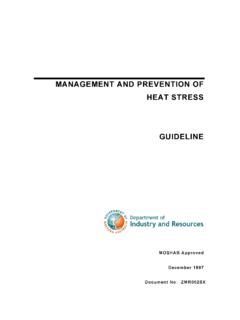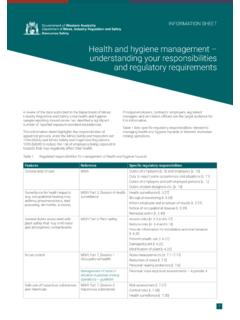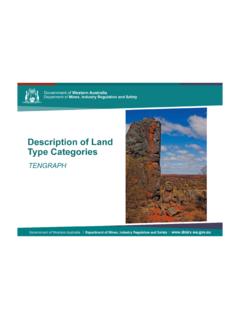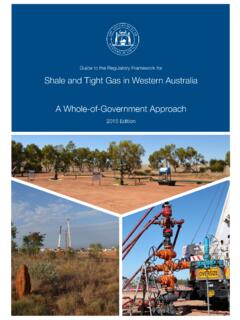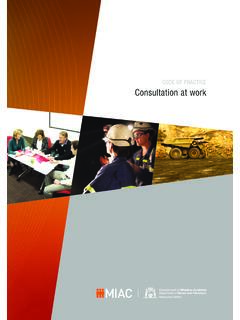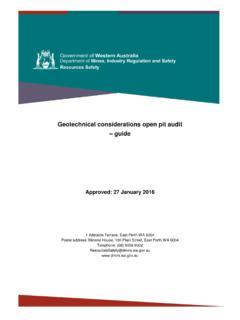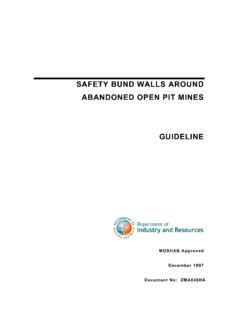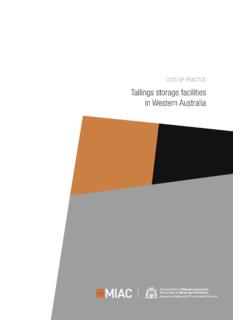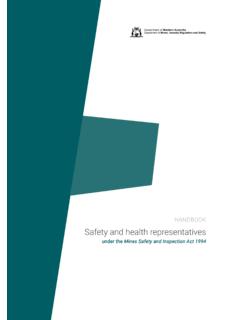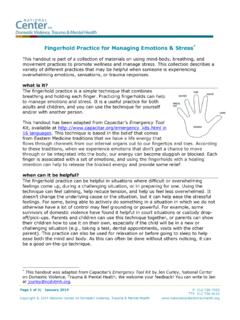Transcription of CODE OF PRACTICE
1 CODE OF PRACTICE working HOURSCODE OF PRACTICEWORKING HOURS2006 commissionfor occupationalsafety and healthCODE OF PRACTICE working HOURSF oreword This code of PRACTICE is issued by the Commission for Occupational Safety and Health and its Mining Industry Advisory Committee under the provisions of the Occupational Safety and Health Act 1984 (the OSH Act) and the Mines Safety and Inspection Act 1994 (the MSI Act).The introduction of the OSH Act enabled the establishment of the tripartite Commission for Occupational Safety and Health.
2 The Commission, which comprises representatives of employers, unions and government, as well as experts, has the function of developing the occupational safety and health legislation and supporting guidance material, and making recommendations to the Minister for Employment Protection for their implementation. To fulfil its functions, the Commission is empowered to establish advisory committees, hold public inquiries, and publish and disseminate information. The Commission s objective is to promote comprehensive and practical preventive strategies that improve the working environment of Western Australians.
3 This code of PRACTICE has been developed through a tripartite consultative process and the views of employers and unions, along with those of government and experts, have been and application of this code In April 2006, the Minister for Employment Protection approved the Code of PRACTICE : working hours pursuant to Section 57 of the OSH Act and Section 93 of the MSI Act. This code of PRACTICE applies to all workplaces in Western Australia covered by either the OSH Act or the MSI Act. It provides guidance for employers and workers on the management of safety and health hazards and risks commonly associated with working hours arrangements and some of the legislative requirements in the OSH Act, the Occupational Safety and Health Regulations 1996 (the OSH Regulations), the MSI Act and the Mines Safety and Inspection Regulations 1995 (the MSI Regulations).
4 It is not possible to deal with every situation that may be found at workplaces. The practical guidance in this document should be considered in conjunction with the general duties in the OSH Act and the MSI Act, as well as specific requirements in these and the OSH Regulations and MSI framework for occupational safety and health TheOccupational Safety and Health Act 1984 The OSH Act provides for the promotion, coordination, administration and enforcement of occupational safety and health in Western Australia.
5 It applies to all industries with the exception of mining and petroleum. With the objective of preventing occupational injuries and diseases, the OSH Act places certain duties on employers, employees, self-employed people, manufacturers, designers, importers and suppliers. The broad duties established by the OSH Act are supported by further legislation, commonly referred to as regulations, together with non-statutory codes of PRACTICE and guidance Safety and Health Regulations 1996 The OSH Regulations have the effect of spelling out specific requirements of the legislation.
6 They may prescribe minimum standards and have a general application, or define specific requirements related to a particular hazard or type of work. They may also allow licensing or granting of approvals and certificates etc. TheMines Safety and Inspection Act 1994 The MSI Act sets objectives to promote and improve occupational safety and health standards within the minerals OF PRACTICE working HOURSThe broad duties set out in the MSI Act are supported by further legislation, commonly referred to as regulations, together with non-statutory codes of PRACTICE and Mines Safety and Inspection Regulations 1995 The MSI Act is supported by the MSI Regulations.
7 Which provide more specific requirements for a range of activities. Like the MSI Act, regulations are enforceable and breaches may result in prosecution, fines or directions to cease operations and undertake remedial of PRACTICE published under the OSH Act and the MSI ActCodes of PRACTICE published under the OSH Act and MSI Act provide practical guidance on how to comply with a general duty or specific duties under the legislation. Codes of PRACTICE may contain explanatory information. However, the preventive strategies outlined do not represent the only acceptable means of achieving a certain standard.
8 A code of PRACTICE does not have the same legal force as a regulation and is not sufficient reason, of itself, for prosecution under the legislation, but it may be used by courts as the standard when assessing other methods or practices used. Regulations and codes of practiceIf there is a regulation about a risk in the OSH Regulations or the MSI Regulations, it must be complied there is a code of PRACTICE about a risk, either: do what the code of PRACTICE says; or adopt and follow another way that gives the same level of protection against the there is no regulation or code of PRACTICE about a risk, choose an appropriate way and take reasonable precautions and exercise proper diligence to ensure obligations are , there may be additional risks at the workplace not specifically addressed in this code of PRACTICE .
9 The OSH Act and the MSI Act require identification and assessment of them and implementation of control measures to prevent or minimise in this publication is provided to assist people in meeting occupational safety and health obligations. While information is correct at the time of publication, readers should check and verify any legislation referenced in this publication to ensure it is current at the time of use. Changes in law after this document is published may impact on the accuracy of information.
10 The Commission provides this information as a service to the community. It is made available in good faith and is derived from sources believed to be reliable and accurate at the time of OF PRACTICE working duties at the hours arrangements and occupational safety and codes of practice32 The risk management process: the three step 1: hazard 2: risk 3: risk approach to risk management Control and review of control measures24 Appendix 1 Relevant sections of acts and regulations25 Appendix 2 Other sources of information26 Appendix 3 Fatigue29 Information for employees31 CODE OF PRACTICE working HOURS11 IntroductionCertain working hours arrangements have been linked to occupational safety and health risks, such as fatigue and impaired performance, and increased exposure to some hazards.
